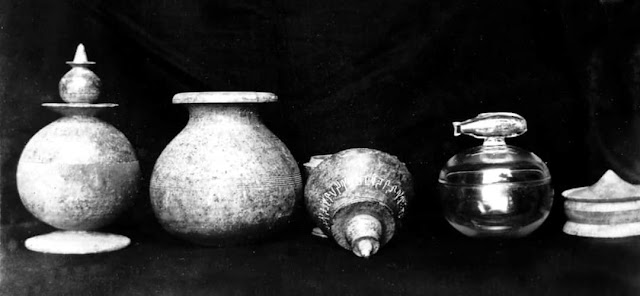Buddha relics and Excavation by William Claxton Peppe.
A buried stupa was discovered by William Claxton Peppe, a British colonial engineer and landowner of an estate at Piprahwa in January 1898. Following the severe famine that decimated Northern India in 1897, Peppe led a team in excavating a large earthen mound on his land. Having cleared away scrub and jungle, they set to work building a deep trench through the mound. After digging through 18 feet of solid brickwork, they came to a large stone coffer which contained five small vases containing bone fragments, ashes, and jewels. On one of the vases was a Dhamma script which was translated by Georg Bühler, a leading European epigraphist of the time, to mean:
Sukiti-bhatinaṃ sabhaginikanam sa-puta-dalanam iyaṃ salila-nidhane Budhasa bhagavate sakiyanam.
"This relic-shrine of divine Buddha (is the donation) of the Sakya-Sukiti brothers, associated with their sisters, sons, and wives,
This inscription implied that the bone fragments were part of the remains of Gautama Buddha, the founder of Buddhism. Throughout the following decade or so, epigraphists debated the precise meaning of the inscription. Vincent Smith, William Hoey, Thomas Rhys Davids, and Emile Senart all translated the inscription to confirm that these were relics of the Buddha.
The bone relics were immediately distributed across several locations, including Golden Mount Temple in Bangkok, Thailand, Shwedagon pagoda in Rangoon, Myanmar, Arakan pagoda in Mandalay, Myanmar, Dipaduttamarama Temple in Colombo, Sri Lanka, Waskaduwe Vihara in Kalutara, Sri Lanka, and the Marichiwatta stupa in Anuradhapura, Sri Lanka.
The majority of the gold and jewelry relic offerings were donated by the Indian government to the Indian Museum, Kolkata. Today, a replica urn is on display. Photographs of the items are on display at the Kapilavastu Museum at Piprahwa that is visited by Buddhist pilgrims.
W. C. Peppe was allowed to retain a number of duplicates which are exhibited in museums today. He also gave some pieces to Prince Prisdang and Prisdang's Buddhist master, Sri Subuthi. A box of 12 flowers was most likely given to Thomas Rhys Davids and the Royal Archaeological Society and discovered as part of a clean up at the Buddhist Society headquarters in London in 2004.
On 16 December 2554 ( 2011), a portion of these Kapilvatthu Buddha Relics was offered to the Sangha of Ratanawan Monastery. In January, 2012, some of these relics were enshrined in the Buddha Homage Reliquary Hall, Ratanawan Monastery, Thailand.
Many senior monks participated in this auspicious ceremony including Ajahn Sumedho and Ajahn Viradhammo.





Comments
Post a Comment